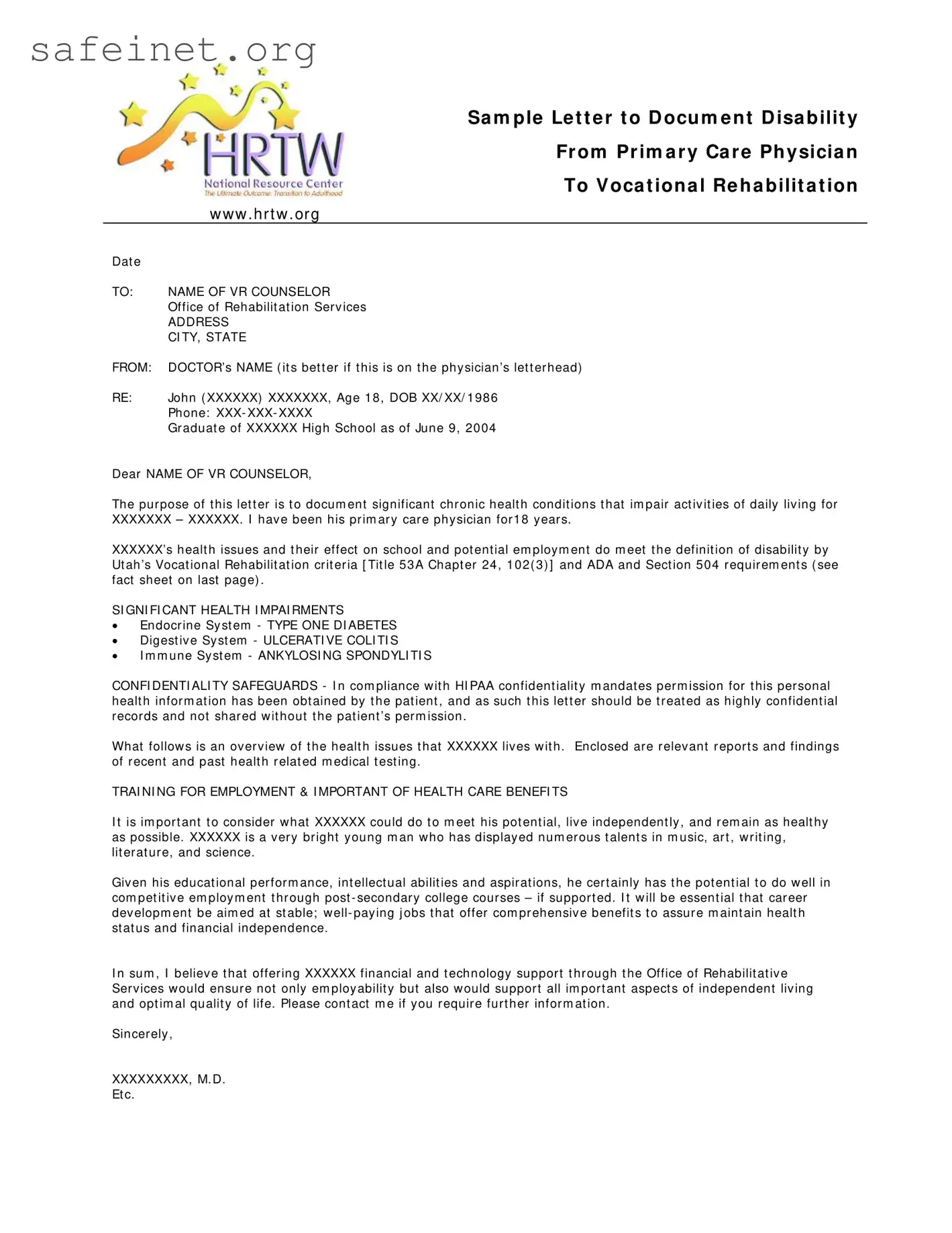Sa m ple Le t t e r t o D ocu m e n t D isa bilit y
Fr om Pr im a r y Ca r e Ph y sicia n
To V oca t ion a l Re h a bilit a t ion
|
w w w . hr t w . or g |
Dat e |
|
TO: |
NAME OF VR COUNSELOR |
|
Office of Rehabilit at ion Ser v ices |
|
ADDRESS |
|
CI TY, STATE |
FROM: |
DOCTOR’s NAME ( it s bet t er if t his is on t he phy sician’s let t er head) |
RE: |
John ( XXXXXX) XXXXXXX, Age 18, DOB XX/ XX/ 1986 |
|
Phone: XXX- XXX- XXXX |
|
Gr aduat e of XXXXXX High School as of June 9, 2004 |
Dear NAME OF VR COUNSELOR,
The pur pose of t his let t er is t o docum ent significant chr onic healt h condit ions t hat im pair act iv it ies of daily liv ing for XXXXXXX – XXXXXX. I hav e been his pr im ar y car e phy sician for 18 y ear s.
XXXXXX’s healt h issues and t heir effect on school and pot ent ial em ploy m ent do m eet t he definit ion of disabilit y by Ut ah’s Vocat ional Rehabilit at ion cr it er ia [ Tit le 53A Chapt er 24, 102( 3) ] and ADA and Sect ion 504 r equir em ent s ( see fact sheet on last page) .
SI GNI FI CANT HEALTH I MPAI RMENTS
•Endocr ine Sy st em - TYPE ONE DI ABETES
•Digest iv e Syst em - ULCERATI VE COLI TI S
•I m m une Sy st em - ANKYLOSI NG SPONDYLI TI S
CONFI DENTI ALI TY SAFEGUARDS - I n com pliance w it h HI PAA confident ialit y m andat es per m ission for t his per sonal healt h infor m at ion has been obt ained by t he pat ient , and as such t his let t er should be t reat ed as highly confident ial r ecor ds and not shar ed w it hout t he pat ient ’s per m ission .
What follow s is an over view of t he healt h issues t hat XXXXXX liv es w it h . Enclosed ar e r elev ant r epor t s and findings of r ecent and past healt h r elat ed m edical t est ing.
TRAI NI NG FOR EMPLOYMENT & I MPORTANT OF HEALTH CARE BENEFI TS
I t is im por t ant t o consider w hat XXXXXX could do t o m eet his pot ent ial, liv e independent ly , and r em ain as healt hy as possible. XXXXXX is a v er y br ight y oung m an w ho has displayed num er ous t alent s in m usic, ar t , w r it ing,
lit er at ur e, and science.
Giv en his educat ional per for m ance, int ellect ual abilit ies and aspir at ions, he cer t ainly has t he pot ent ial t o do w ell in com pet it ive em ploy m ent t hr ough post - secondar y college cour ses – if suppor t ed. I t w ill be essent ial t hat car eer dev elopm ent be aim ed at st able; w ell- pay ing j obs t hat offer com pr ehensiv e benefit s t o assur e m aint ain healt h
st at us and financial independence.
I n sum , I believ e t hat offer ing XXXXXX financial and t echnology suppor t t hr ough t he Office of Rehabilit at iv e
Ser v ices w ould ensur e not only em ploy abilit y but also w ould suppor t all im por t ant aspect s of independent living and opt im al qualit y of life. Please cont act m e if y ou r equir e fur t her infor m at ion .
Sincer ely ,
XXXXXXXXX, M. D.
Et c.
|
X X X X X X X X X X X X |
Ch r on ic H e a lt h I ssu e s |
1 . |
TYPE ON E D I ABETES, I CD- 9 CODE: 250 . 01, Diagnosed: 1998; age 12 y ear s |
|
Healt h I m pact t o XXXXXX – He r equir es daily insulin, st r ict diet ar y m anagem ent , and daily / hour ly |
|
m onit or ing and m anagem ent of blood sugar lev els. He has been hospit alized sev er al t im es, eit her for |
|
sev er e hy pogly cem ia or k et oacidosis. |
|
2 . |
U LCERATI V E COLI TI S, I CD- 9 CODE: 556 . 9, Diagnosed: Diagnosed 2000; age 14 y ear s |
|
XXXXXX r equir ed sur ger y for t his. He had a colect om y . |
|
Healt h I m pact t o XXXXXX – Alt hough he t echnically no longer has ulcer at iv e colit is due t o t he absence of a |
|
colon, he cont inues t o suffer fr om acut e episodes of pouchit is. Sy m pt om s, including st eadily incr easing |
|
st ool fr equency t hat m ay be accom panied by incont inence, bleeding, fev er and/ or feeling of ur gency . Most |
|
cases can be t r eat ed w it h a shor t cour se of ant ibiot ics. Addit ionally , absence of a colon causes pr oblem s |
|
w it h nut r it ional absor pt ion and is associat ed w it h XXXXXX’s below - aver age w eight . |
3 . |
AN KYLOSI N G SPON D YLI TI S, I CD- 9 CODE: 720 . 0, Diagnosed: 2000; age 14 y ear s |
|
Healt h I m pact t o XXXXXX – his degener at iv e spinal ar t hr it is t hat causes episodes of sev er e pain and |
|
lim it at ions on his physical capabilit ies, r equir ing m edicat ion and a phy sical t her apy r egim e for |
|
m anagem ent . |
|
ACCOM OD ATI ON S REQU I RED – SCH OOL / EM PLOYM EN T TRAI N I N G/ PREPARATI ON
I n or der t o m ax im ize XXXXXX’s per for m ance lev el t hat w ill not j eopar dize healt h st at us, som e accom m odat ions and m odificat ions ar e r equir ed:
1 . |
DAI LY MONI TORI NG- XXXXXX’s diabet es m anagem ent r equires t hat he be able t o t ak e fr equent br eak s w hen |
|
t he need ar ises t o a) t r eat low blood sugar s, b) use t he r est r oom , c) t est his glucose levels, and d) adm inist er |
|
insulin . Alt hough XXXXXX’s diabet es m anagem ent has been r elat iv ely st able, t he pr esence of addit ional |
|
aut oim m une diseases put s his fut ur e diabet es m anagem ent and long - t er m healt h at r isk . |
2 . |
WATER I NTAKE & BATHROOM BREAKS - XXXXXX’s lack of a colon causes him t o use t he r est r oom fr equent ly , |
|
and he m ust dr ink a lar ge am ount of w at er t hr oughout t he day t o pr ev ent dehy dr at ion . |
3 . |
LI MI T PHYSI CAL EXERTI ON - His ank y losing spondy lit is causes him day s w it h sev er e back pain, m ak ing |
|
r igor ous act iv it y v er y painful. Task s r equir ing heav y lift ing or hav ing t o sit or st and for a pr olonged per iod of |
|
t im e w it hout br eaks exacer bat e his condit ion and ar e har m ful t o his spine. Class schedules and locat ion of |
|
classr oom s, t im e needed t o change t r av el t o nex t class need t o be ev aluat ed . Ther e m ay be a need for |
|
addit ional accom m odat ions in t he fut ur e, such as m obilit y assist ance, elev at or use, use of lapt op or cell phone |
|
t o allev iat e unnecessar y phy sical t r av el. |
4 . |
ATTENDANCE - Episodes of sev er e hy pogly cem ia or k et oacidosis, pouchit is infect ions, and sev er e spinal pain |
|
can r esult in XXXXXX’s need for addit ional sick days t o t r eat t he accom pany ing fever , diar r hea, and abdom inal |
|
pain . Teacher s w ill need t o allow for incr eased t im e t o m ak e up schoolw or k or ot her for m s of inst r uct ion if |
|
absent eeism is due t o not ed healt h issues. |
5 . |
ACCOMODATI ONS - XXXXXX has had a 504 plan in place at school ( K- 12) t o ensur e t hese accom m odat ions |
|
hav e been allow ed. The indiv idualized em ploy m ent plan / indiv idual w r it t en r ehabilit at ion plan, t hat w ill be |
|
dev eloped bet w een VR and XXXXXX w ill need t o specify needed accom m odat ions. While in college, XXXXXX |
|
w ill need t o coor dinat e accom m odat ions ( healt h, lear ning and t est ing) for m ax im ized per for m ance w it h t he |
|
Disabilit y Resour ce Cent er s on cam pus. |

